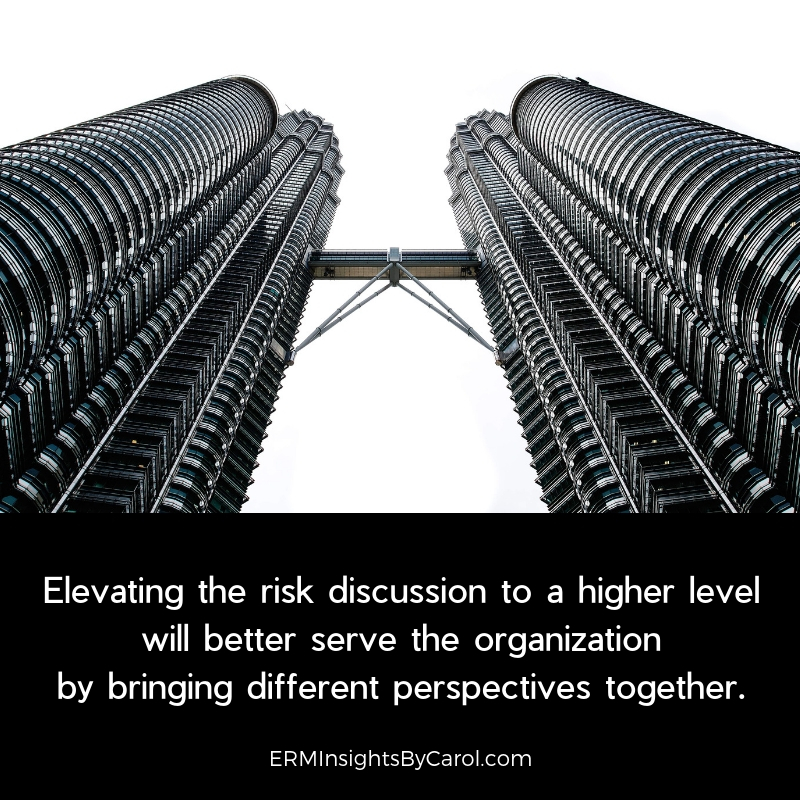One of my most popular articles discusses the differences between traditional risk management and ERM, with one of the core differences being the approach to risk.
Traditional risk management occurs within a singular business unit – it is departmentalized or occurs in what’s called a “silo” or “stove pipe.” The IT Director or Chief Technology Officer focuses on technology risks, the Chief Counsel focuses on legal risk, and so on. Little to no communication about risk management activities will occur between the departments.
Despite the lack of communications, all organizations, regardless of size, conduct risk management in one way or another.
The “traditional” approach outlined above has by far been the most common way organizations manage their risks. This stove-pipe approach has many drawbacks though…
First, managing risks within the department could unknowingly create risks to other areas of the organization. As an example, addressing a legal risk could lead to a new reputation risk that is much more damaging.
An even more significant drawback is that many risks won’t apply to just one department and get overlooked altogether…this is especially true of risks to achieving strategic objectives. Situations like this require departments to coordinate. What often happens though is one department doesn’t want to take ownership. They may feel the effects of the risk but lack the ability to manage it.
I ran into this when facilitating a workshop with a business unit. At least half of the risks they identified applied to multiple departments or even the entire organization. The business unit felt they didn’t own these risks since there was nothing they could do to reduce the risk or change the process. Therefore, although these organizational risks were risk, this department ended up only assessing and analyzing those risks that only they felt comfortable managing.
Although the conversation was occurring at the department level and many of the risks applied to multiple areas of the organization, the business unit could only articulate how the risk was going to impact them.
ERM elevates risk management from an ad-hoc exercise at the department level to a top-level, enterprise-wide process that looks at more than just operational hazards.
As explained by Dr. Mark Beasley of NC State University’s ERM Initiative, traditional risk management takes a more functional view of risks, and unlike ERM, doesn’t consider risks from a strategic or implementation perspective and how they could derail the organization from achieving its goals.
At the most fundamental level, viewing risks at the department level will produce a skewed view of threats, not to mention that it doesn’t even consider positive risks that can help achieve goals faster or open up new opportunities altogether.
In order to ensure the organization is addressing enterprise-wide opportunities and threats that either help or hinder it from achieving its goals, there must be collaboration and coordination between departments.
Establishing a non-executive, cross-functional working group is one way to begin having the collaboration needed to truly understand and manage enterprise risks.
By cross-functional, I mean representatives from different areas of the company who come together to discuss risks that transcend any particular business unit and make decisions on how to take action.
First, this provides much needed perspective on the significance of a particular risk. What may seem like a big deal to the business unit is, after careful examination from across the company, determined to not really be a threat to the organization as a whole.
The working group can also better assess risks that fall between siloes and more easily determine who the true owner should be. This, of course, addresses those situations where a business unit may feel the impact from a risk but another unit is able to actually address it.

One word of caution…
The cross-functional team concept might give the impression that you as a risk professional think a particular department is not capable of assessing risks.
It’s important to clarify that bringing additional people to the discussion is not an indictment of the department. Rather, elevating the discussion to include other areas of the organization will better serve the organization by bringing different perspectives together.
Is your organization only looking at risks from a functional or operational perspective at the department level or are you taking an eagle’s eye view of the entire enterprise? How do you bring the different perspectives together?
I’m interested to hear your thoughts on this fundamental concept of ERM and how it is progressing in your organization. I invite you to leave a comment below or join the conversation on LinkedIn.
I also recommend checking out the traditional vs. ERM article if you haven’t done so to better understand other key differences between the two concepts.
And if your organization is trying to move your risk management from a department-level approach to an enterprise-wide one, please contact me to discuss ways you can go about doing this that fit with your organization’s leadership, industry, culture, and more.








